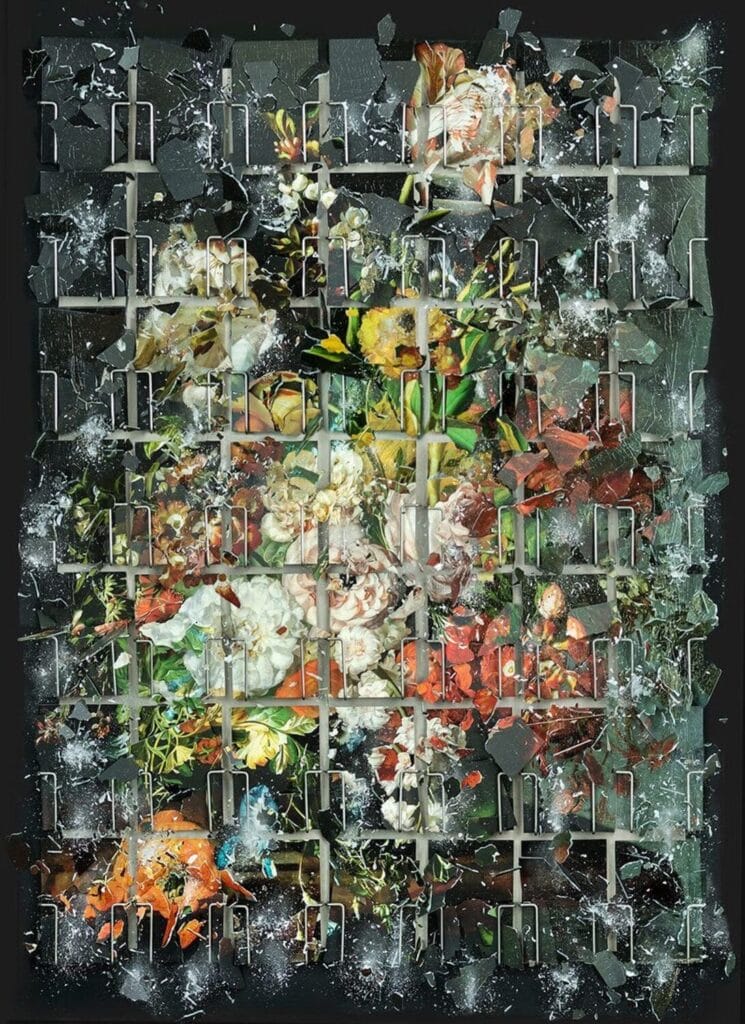Talley Dunn Gallery is proud to start the New Year with a major exhibition by internationally renowned, London-based photographer Ori Gersht. Fields and Visions will run from January 14 – March 25, 2023. This exhibition will include new works along with a site-specific video installation. We invite you to join us in welcoming Ori Gersht on Saturday, January 14th with an in-depth artist talk and exhibition walk-through at 3pm and reception for the artist from 5pm – 7pm.
In Fields and Visions, Gersht returns to the botanical themes that have occupied him for so much of the last decade. The inspiration for this new work comes from the Swiss naturalist Maria Sibylla Merian, who travelled to Suriname (Dutch Guiana) in the 17th century and was the first artist to study and record native tropical plants and insects from that region, and the paintings of the American artist Martin Johnson Heade, who travelled to Amazonia in the 19th century in search of hummingbirds and exotic orchids. Despite its convincing realism, their paintings and drawings reveal a fusion of fact and fiction, to create a unique and mysterious world that ignites our imagination.

Ori Gersht
- “In all my work there is a tension between a desire to hold on to something, to have some form of eternal assurance — and then a submission to the ephemeral, to the awareness that things fall apart.”
Inspired by the pioneering efforts of these artists from the 17th and 19th centuries, Gersht’s new photographic works re-examine the relationship between artistic representation and the deceptive photographic claim of a single objective truth. However, instead of travelling to remote places, Gersht has reproduced these exotic locations in his studio, bringing them to life with sudden violent disturbances to reinforce the authentic moment recorded by the camera. Then, with the aid of artificial intelligence software, he enlarges the low resolution photographs, inviting the computer to fill in the missing information and reshape the images. In a sense, the software is required to use its acquired knowledge to reimagine the events and to present a new form of realism, fused naturally together.
The combination of the faithful trace of the optical lens in harmony with the computerised interpretation of the artificial intelligence registers a shift in our concept of reality, as these photographs are no longer a faithful depiction of the physical subject matter. The use of the artificial intelligence transforms the nature of photographic representation and this new part optical, part digital reality presents a shift in the discourse of authentic photographic vision, as the artificial intelligence redefines our perception of realism and in so doing, detaches the photographs from a particular time or place.

The Becoming series explores the fundamental relationship between creation and entropy through the canonical structure imposed by museums upon their collections. In the artist’s studio, images of paintings drawn from the postcard collections of the Metropolitan Museum of Art, New York, The Getty Museum, Los Angeles, and the Rijksmuseum, Amsterdam are printed onto analogously sized sheets of glass and then carefully arranged on a specially constructed wall that mimics a traditional postcard display. Order cedes to chaos as each wall of glass is methodically shattered. Recorded by the camera at the instant of destruction, a new space of creation emerges. In this photographic space, Gersht visualizes the entropic forces that these institutional systems resist as the images shatter into dispersed fragments of collective memory, perhaps returning to the state of disorder from which they originated.
Ori Gersht (b. 1967, Tel-Aviv) earned his BFA in Photography, Film & Video from the University of Westminster, London in 1992 and completed his Master of Photography at the Royal College of Art, London in 1995. Gersht’s work explores the connection between history, memory, and landscape. His work tends to present exquisite images underscored by darker associations of conflict. A recent trilogy of films in which traditional still-lifes explode in slow motion has received particular renown. Much of his work connects with art historical genres such as the still life and the landscape, and the particular modes of looking that these genres imply.
Gersht has been honored with solo exhibitions at the Hirshhorn Museum and Sculpture Garden, Washington, D.C. (2009); the Tel Aviv Museum (2012 and 2015); the Museum of Fine Arts, Boston (2012); the Center for Contemporary Art, Tel Aviv (2013); the Columbus Museum of Art, Columbus, Ohio (2014); and the Museum Kurhaus Kleve, Kleve, Germany (2015). His work is held by major collections including the Hirshhorn Museum and Sculpture Garden; the Museum of Fine Arts, Boston; the Museum of Modern Art, San Francisco; the Guggenheim Museum, New York; the Los Angeles County Museum of Art; The Getty Museum, Los Angeles; the Knoxville Museum of Art, Tennessee; Tate, London; the Victoria & Albert Museum; the UK Government Art Collection; the Tel Aviv Museum of Contemporary Art, Tel Aviv; and the Israel Museum, Jerusalem. Gersht lives and works in London, where he has been based for the past twenty years.
Talley Dunn Gallery
5020 Tracy St, Dallas, TX 75205










